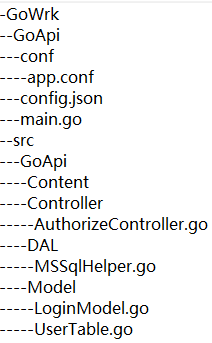Program directory structure

Simple implementation, the user logs in and returns a jwt token. The next request takes a token to request the user information interface and return the information.
The app.conf file content (which can be read directly by a beego) is written as a jwt secretkey
jwtkey="12345678"
The user name and password of the connection database are stored in config.json (here we just learn how to read json's configuration file, which can be integrated into beego's app.conf file)
{
"sqltype":"mssql"
,"connstring":"server=.;port=1433;user id=sa;password=123;database=table1"
}
MSSqlHelper.go Implements Connecting mssqlserver's Database
package mssqlhelper
import (
"fmt"
"github.com/akkuman/parseConfig"
_ "github.com/denisenkom/go-mssqldb"
"github.com/go-xorm/core"
"github.com/go-xorm/xorm"
)
// Create XORM client
func CreateClient() *xorm.Engine {
var config = parseConfig.New("config.json")
sqltype := config.Get("sqltype")
fmt.Println(sqltype)
connstring := config.Get("connstring")
fmt.Println(connstring)
engine, err := xorm.NewEngine(sqltype.(string), connstring.(string))
if err != nil {
println("open error:", &err)
}
engine.SetMapper(core.SameMapper{}) //The name of the class representing Struct is the same as in the database
engine.ShowSQL(true) //Display SQL statements
engine.Logger().SetLevel(core.LOG_DEBUG) //Print SQL statements
return engine
}
AuthorizeController.go Implements User Login and Gets User Information Interface
package controller
import (
"GoApi/DAL"
"GoApi/Model"
"encoding/json"
"fmt"
"net/http"
"strconv"
"strings"
"time"
"github.com/astaxie/beego/context"
"github.com/astaxie/beego"
jwt "github.com/dgrijalva/jwt-go"
"github.com/go-xorm/xorm"
)
var engine *xorm.Engine
type AuthorizeController struct {
beego.Controller
}
var filterUser = func(ctx *context.Context) {
token := ctx.Input.Header("Authorization")
b, _ := CheckToken(token)
//Verify that Token is legal
if !b {
http.Error(ctx.ResponseWriter, "Token verification not pass", http.StatusBadRequest)
return
}
fmt.Println("Request token:", token)
}
func init() {
engine = mssqlhelper.CreateClient()
//Verify token before accessing the interface
beego.InsertFilter("/Authorize/Userinfo", beego.BeforeRouter, filterUser)
}
type Token struct {
Token string `json:"token"`
}
func fatal(err error) {
if err != nil {
beego.Error(err)
}
}
//Sign in
func (this *AuthorizeController) Login() {
var user Model.LoginModel
// Url? Username = 111 & password = 222
user.UserName = this.GetString("username")
user.PassWord = this.GetString("password")
//Er: = this. ParseForm (& user) // Receive application/x-www-form-urlencoded POST transfer data, such as Username = 111 & Password = 2222
// Er: = json. NewDecoder (this. Ctx. Request. Body). Decode (& user) // / Receives data in JSON form Post
loginuser := &Model.Usertable{Userloginname: user.UserName}
has, err := engine.Get(loginuser)
if err != nil {
fatal(err)
}
if !has {
fatal(err)
http.Error(this.Ctx.ResponseWriter, "User Not Exist", http.StatusBadRequest)
return
}
if user.PassWord != loginuser.Userloginpwd {
this.Ctx.Output.Header("SetStatus", strconv.Itoa(http.StatusBadRequest))
http.Error(this.Ctx.ResponseWriter, "Password Wrong", http.StatusBadRequest)
return
}
claims := make(jwt.MapClaims)
claims["exp"] = time.Now().Add(time.Hour * time.Duration(1)).Unix()
claims["iat"] = time.Now().Unix()
claims["nameid"] = loginuser.Userloginname
claims["User"] = "true"
token := jwt.NewWithClaims(jwt.SigningMethodHS256, claims)
tokenString, err := token.SignedString([]byte(beego.AppConfig.String("jwtkey")))
if err != nil {
this.Ctx.Output.Header("SetStatus", strconv.Itoa(http.StatusInternalServerError))
fatal(err)
http.Error(this.Ctx.ResponseWriter, "Server is Wrong", http.StatusInternalServerError)
return
}
fmt.Println("Token:", tokenString)
this.Ctx.WriteString(fmt.Sprintf("{\"Token\":\"%s\"}", tokenString))
}
func (this *AuthorizeController) Userinfo() {
token := this.Ctx.Input.Header("Authorization")
b, t := CheckToken(token)
if !b {
this.Ctx.WriteString(fmt.Sprintf("Error:%s", token))
return
}
loginuser := &Model.Usertable{Userloginname: claims["nameid"].(string)}
has, err := engine.Get(loginuser)
if err != nil {
fatal(err)
}
if !has {
fatal(err)
http.Error(this.Ctx.ResponseWriter, "User Not Exist", http.StatusBadRequest)
return
}
data, err := json.Marshal(loginuser)
if err != nil {
fmt.Println(err)
}
this.Ctx.WriteString(fmt.Sprintf("{\"Token\":\"%s\",\"User\":%s}", token, string(data)))
}
// Check whether token is valid
func CheckToken(token string) (b bool, t *jwt.Token) {
kv := strings.Split(token, " ")
if len(kv) != 2 || kv[0] != "Bearer" {
beego.Error("AuthString invalid:", token)
return false, nil
}
t, err := jwt.Parse(kv[1], func(*jwt.Token) (interface{}, error) {
return []byte(beego.AppConfig.String("jwtkey")), nil
})
fmt.Println(t)
if err != nil {
fmt.Println("Convert to jwt claims fail.", err)
return false, nil
}
return true, t
}
Structure of LoginModel.go submitting login username and password
package Model
type LoginModel struct {
UserName string `xorm:"VARCHAR(50)"`
PassWord string `xorm:"VARCHAR(50)"`
}
UserTable.go User Information Entity Structure
package Model
type Usertable struct {
Userid int `xorm:"not null pk INT(4)"`
Userloginname string `xorm:"VARCHAR(50)"`
Userloginpwd string `xorm:"VARCHAR(50)"`
Username string `xorm:"NVARCHAR(200)"`
Usermobile string `xorm:"VARCHAR(11)"`
Userislock int `xorm:"BIT(1)"`
}
Start http web services through beego in main.go
package main
import (
"GoApi/controller"
"github.com/astaxie/beego"
)
func main() {
beego.AutoRouter(&controller.AuthorizeController{})
beego.Run()
}
Next step
1. Learn how to intercept validation in the interceptor and pass a result value to the interface to be accessed (currently, to parse jwt token once again in the interface)
2. How beego implements an interface that allows only post access to a controller (in AutoRouter mode)
3. How does Struct implement the Chinese description (that is, the Chinese description will be displayed when the mouse is placed, similar to the description of C#)